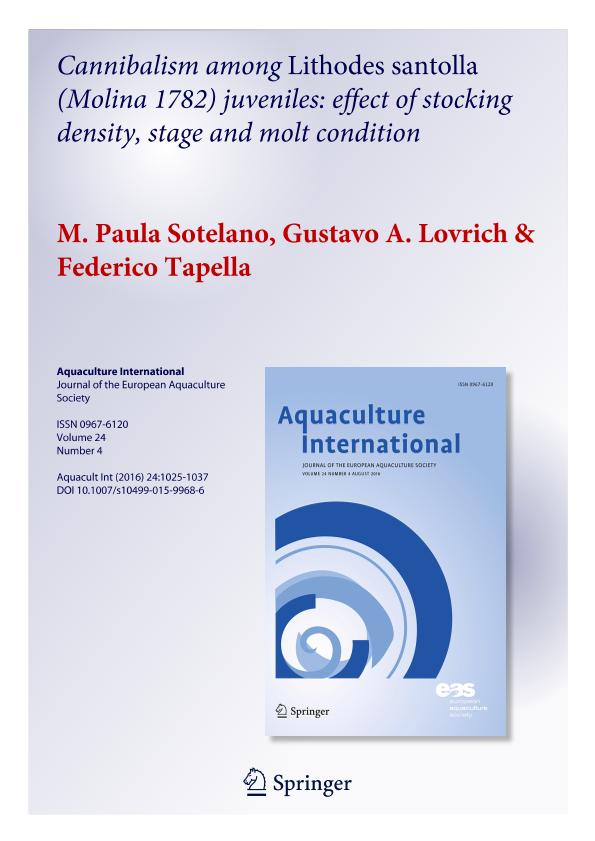Artículo
Cannibalism among Lithodes santolla (Molina 1782) juveniles: effect of stocking density, stage and molt condition
Fecha de publicación:
08/2016
Editorial:
Springer
Revista:
Aquaculture International
ISSN:
0967-6120
Idioma:
Inglés
Tipo de recurso:
Artículo publicado
Clasificación temática:
Resumen
Losses of king crabs (deaths) in massive rearing conditions are frequently attributed to cannibalism. As several factors could influence cannibalism intensity during culture, the aim of the present study was to determine the effect of molt condition, stage and density on cannibalism among Lithodes santolla juveniles. Comparisons between intermolt and molt conditions and between C1 and C2 stages during intermolt were performed at three densities (6, 12 and 18 individuals per flask; that is equivalent to 236, 472 and 708 individuals m−2). After 16 days of juvenile coexistence, cannibalism (injured + dead) was higher during molting (33.9 ± 4.5 %) than intermolt (21.7 ± 3.9 %), even though only 36 % of crabs had molted. Although cannibalism was similar in C1 and C2 stages, the proportion of dead animals was higher by a factor of three in C1 stage, probably due to the fact that animals reach the first juvenile stage with low energetic reserves, after the lecithotrophic larval development. Density was the main factor influencing cannibalism in our experiments. Higher densities promoted higher deaths, while agonistic interactions evidenced by injured crabs remained constant. Walking appendages were lost more often than chelipeds during first agonistic encounters. We recommend the use of intermediate densities (450 crabs m−2 at most), the early detection of exuviae and the sorting of crabs after molting, for L. santolla rearing.
Palabras clave:
CANNIBALISM
,
CULTURE
,
JUVENILES
,
SOUTHERN KING CRAB
,
STOCK ENHANCEMENT
Archivos asociados
Licencia
Identificadores
Colecciones
Articulos(CADIC)
Articulos de CENTRO AUSTRAL DE INVESTIGACIONES CIENTIFICAS
Articulos de CENTRO AUSTRAL DE INVESTIGACIONES CIENTIFICAS
Citación
Sotelano, María Paula; Lovrich, Gustavo Alejandro; Tapella, Federico; Cannibalism among Lithodes santolla (Molina 1782) juveniles: effect of stocking density, stage and molt condition; Springer; Aquaculture International; 24; 4; 8-2016; 1025-1037
Compartir
Altmétricas




